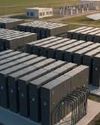Tech-powered emission controls enhance power plant performance
EPR Magazine (Electrical & Power Review)
|June 2025
These innovative technologies support sustainable energy production and contribute to broader climate change mitigation efforts by minimising the environmental footprint of power generation.
-

Power plants are essential for meeting global energy demands. However, their operations release significant quantities of air pollutants, including sulfur oxides (SOx), nitrogen oxides (NOx), particulate matter (PM), mercury and greenhouse gases. A range of emission control products and technologies are used to reduce these emissions and comply with increasingly stringent environmental regulations. Many leading companies have started emphasising the use of primary emission control products in power plants, their working principles and their effectiveness in reducing pollution.
Advanced emission control products and technologies
FGD (Flue Gas Desulphurisation) systems, commonly known as scrubbers, are used to remove SOx from the flue gases of fossil-fuel power plants. The most prevalent type is the wet limestone scrubber, which uses a slurry of limestone and water to absorb SO₂, converting it into gypsum, a usable byproduct. Dry and semi-dry scrubbers are used, especially in smaller plants or where water availability is limited. FGD systems have the potential to remove up to 95 per cent of SO₂ emissions and produce gypsum in the plants, which can be further used in construction activities.
Moreover, selective catalytic reduction (SCR) and selective non-catalytic reduction (SNCR) are post-combustion technologies used to reduce nitrogen oxide (NOx) emissions in power plants. SCR uses a metal-based catalyst and injects ammonia or urea into the flue gas, facilitating a reaction at lower temperatures to convert NOx into harmless nitrogen and water achieving up to 90 percent NOx reduction. In contrast, SNCR does not use a catalyst; instead, it injects ammonia or urea directly into the hot flue gas at higher temperatures, where it reacts with NOx to form nitrogen and water typically achieving 30–70 percent reduction, however, with greater variability and lower efficiency than SCR.
Diese Geschichte stammt aus der June 2025-Ausgabe von EPR Magazine (Electrical & Power Review).
Abonnieren Sie Magzter GOLD, um auf Tausende kuratierter Premium-Geschichten und über 9.000 Zeitschriften und Zeitungen zuzugreifen.
Sie sind bereits Abonnent? Anmelden
WEITERE GESCHICHTEN VON EPR Magazine (Electrical & Power Review)

EPR Magazine (Electrical & Power Review)
Wirepas certification a major step toward India's upcoming phase of AMI deployments
The Wirepas Certified programme is a major advancement for India's massive AMI deployments. This affirms device suitability for the diverse and challenging environments in the country. Teppo Hemiä, CEO of Wirepas discusses more with EPR.
2 mins
December 2025

EPR Magazine (Electrical & Power Review)
BESS becoming the backbone of power capacity additions
India is undergoing a rapid clean energy revolution, aiming to deploy 500 GW of non-fossil capacity by 2030, of which it has already reached 250 GW.
6 mins
December 2025

EPR Magazine (Electrical & Power Review)
Transformer industry undergoes evolution to meet capacity addition
The projected increase of over 433,000 MVA in substation capacity nationwide has served as a guiding force for the transformer sector. Amit Varshney shares his expertise in talks with EPR.
3 mins
December 2025

EPR Magazine (Electrical & Power Review)
RenewSys elevates solar module reliability with advanced encapsulant technologies
To enhance the efficiency and reliability of its products, RenewSys has introduced advanced encapsulants and backsheets, including AA EVA (Anti-Acid) to combat internal corrosion, ENT POE to guarantee PID-free performance, and environmentally friendly options like the Green Backsheet.
2 mins
December 2025
EPR Magazine (Electrical & Power Review)
REC facilitates MoU between MePDCL and CPRI for quality testing in Meghalaya
REC Limited, a Maharatna Public Sector Enterprise under the Ministry of Power and a leading NBFC, has successfully mediated a crucial Memorandum of Understanding (MoU) between Meghalaya Power Distribution Corporation Limited (MePDCL) and the Central Power Research Institute (CPRI).
1 min
December 2025

EPR Magazine (Electrical & Power Review)
SECI, Andhra finalise 1200 MWh BESS and 50 MW hybrid project
Solar Energy Corporation of India Limited (SECI), a Navratna CPSU under the Ministry of New & Renewable Energy (MNRE), Government of India, has exchanged Government Orders (GOs) with the Government of Andhra Pradesh for the development of a 1200 MWh Battery Energy Storage System (BESS) at Nandyal and a 50 MW Hybrid Solar Project.
1 min
December 2025

EPR Magazine (Electrical & Power Review)
Convergence of digitalisation, automation, and electrification is the foundation of next-gen infra
Panasonic Life Solutions India is on a mission to contribute to reliable, sustainable electrification across various sectors in the country. Shahab Naqvi shares insights about the company's strategies in talks with EPR. Let us know more from him.
3 mins
December 2025

EPR Magazine (Electrical & Power Review)
FY26 to attract $20-25 bn in renewable investments in India
The renewable energy sector in India has just hit a turning point. Between April and August 2025, the country added a record 20.1 gigawatts (GW) of renewable power capacity, a 123 per cent increase compared to the same period last year, when additions totalled just 9 GW. According to data from the Ministry of New and Renewable Energy (MNRE) and market observers like ICRA, this pace positions India to cross 35 GW of new capacity by the end of FY26, the highest annual addition in its clean-energy history.
3 mins
December 2025

EPR Magazine (Electrical & Power Review)
Wirepas certification a major step toward India's upcoming phase of AMI deployments
This certification provides DISCOMs and AMISPs with confidence that a device has passed the toughest real-world tests for scalability, interoperability and reliability.
2 mins
December 2025

EPR Magazine (Electrical & Power Review)
Renewable surge strains the grid as storage strengthens stability
The CEA mandates co-located ESS (approx. 2 hours) for new solar projects, aiming to reach 60 GW of storage by FY 2032 (including 42 GW of BESS and 19 GW of pumped hydro).
3 mins
December 2025
Listen
Translate
Change font size

